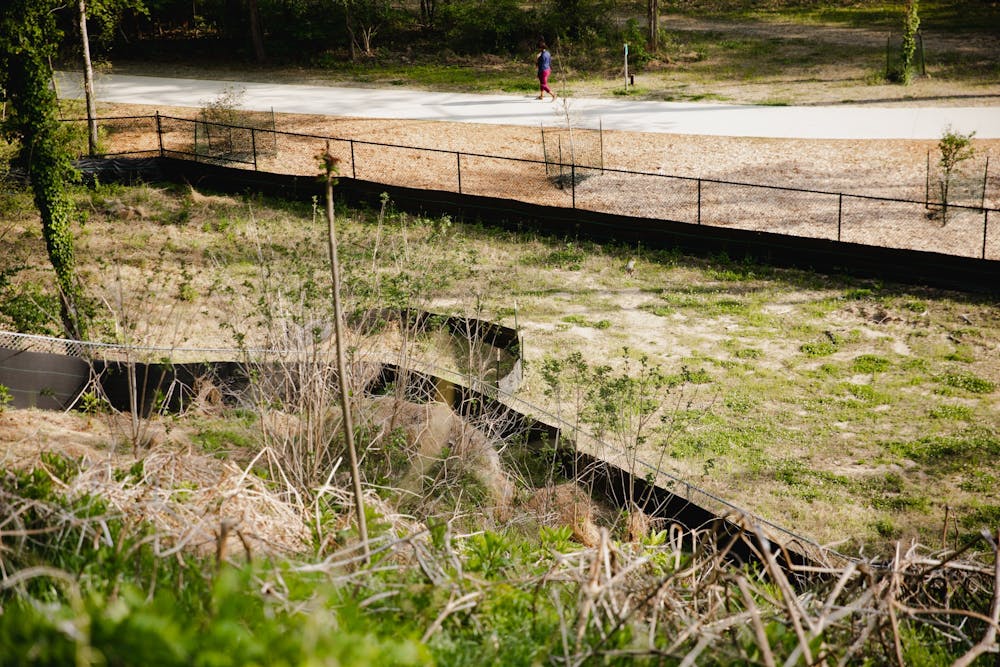The Town plans to move forward with an economic development agreement in June. They will then enter a 12-18-month environmental risk assessment process, followed by an environmental management plan for site activities that will be prepared by environmental engineers.
Risk assessment
In 2019, environmental consulting firm Hart & Hickman completed its risk assessment of the site. The report determined the lot can be repurposed safely without removing all of the existing coal ash and debris. It also recommended interim measures to remove coal ash located close to Bolin Creek.
Torrey added that the cancer risk threshold of coal ash exposure had been modified from 1-in-100,000 under the 2019 Environmental Risk Assessment to 1-in-10,000 in the 2021 Environmental Risk Assessment conducted by Hart & Hickman.
Chapel Hill Economic Development Specialist Laura Selmer said because the risk assessment looks at the site in its current state — as opposed to potential risk once the site is fully developed — it is reasonable to assume any actions the Town takes will lower the risk of exposure to cancer-causing materials even further.
“We’re confident that with the proper mitigation measures, we’ll achieve a safe site,” she said.
In response, the Town removed around 1,000 tons of coal ash and soil near the Bolin Creek Trail in 2020, though some coal ash still remains on the site.
If the site is developed, the Town plans to cap, contain and cover the coal ash, which would reduce community risk and exposure to potential containments.
Town officials estimate that removing the coal ash would cost between $13 and $16 million and would take three or more years to complete, in a fact sheet on the Town’s website. They also state that removing the ash could prove hazardous to Bolin Creek and surrounding communities.
Concerns persist
Despite assurances from Town Council members and local officials, some residents and environmental advocates have been critical of the Town’s proposals.
Torrey said that the Town should go beyond the minimum standards to protect the community and to protect clean water.
To get the day's news and headlines in your inbox each morning, sign up for our email newsletters.
“What we’ve urged all along is that the Town do the maximum possible to protect people and to protect clean water, and that includes being willing to commit to going beyond the minimum standards that the state might allow for this project," he said. "So that’s something they need to do more to commit to.”
Pamela Schultz, an environmental engineer and a member of the Chapel Hill Stormwater Advisory Board, was critical of the Town’s claim that 5,000 truckloads would be required to remove all the coal ash. She said that the true number would likely be lower.
The estimate was derived from a 2017 report, but the Town’s consultants have recently said the amount of ash on the site is probably lower than their initial estimates. However, the Town has not lowered its estimate of the number of truckloads.
"The Town has said many times that they don’t think it’s as much as they originally estimated," Schultz said.
The Brownfields Program
In 2019, the site was declared eligible for the Brownfields Program, which would allow the North Carolina Department of Environmental Quality to work with prospective developers to clean up and redevelop sites that currently pose a risk of environmental contamination.
Environmental lawyer Robert Gelblum said the Brownfields program is typically used when a developer wants to repurpose a site with potential contamination, but is worried about liability.
“So they get this agreement whereby, instead of paying millions and millions of dollars to have to literally clean up and remediate the pollution, they negotiate this agreement which typically only requires land-use restrictions,” he said.
According to Gelblum, such land-use restrictions include a prohibition on the use of groundwater and the development of senior and childcare centers.
He believes developers typically prefer these land-use restrictions to removing environmental contaminants.
“There’s no doubt the developer is hoping to avoid actual clean-up costs,” he said.
Moving forward, Schultz said that she would favor removing the ash that is easily accessible on the slope.
“In remediation, you’d call this source removal, where you know you’re not going to get 100 percent of the contaminated material, but you do your best to try and get the most concentrated potential source of future exposure and risk,” she said.
Searing added that he would like to see the Town reevaluate costs associated with removing the coal ash.
“I’d like to get three new estimates about how much it costs to move (the coal ash) and where it would go, and not from companies that we’re paying to tell us what we want to hear,” he said.
@ianwalniuk
@DTHCityState | city@dailytarheel.com



